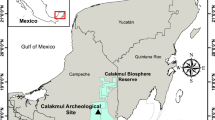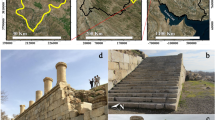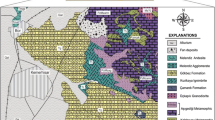Abstract
Diagnosing the weathering of stones used in built heritage is essential for their preservation. Samples taken from the surface and the core stones of Al-Ziggurat walls in the archaeological city of Al-Nimrud (North Iraq) were characterized. Stone samples from a quarry believed to be the origin of the stones used in the construction of Al-Nimrud were also characterized. Physical properties, pore space system, mineralogical and chemical compositions and microstructural properties of historic, fresh and weathered stones were determined by various complementary techniques at the microscopic level. Results show that the main damage observed on the stone surface of Al-Ziggurat walls is due to salt weathering. Gypsum is the predominant salt and probably originated from the soil in contact with the stones during burial of the walls. Results also indicate that the characteristics of samples of the core of historic stone are quite similar to those of the fresh stone extracted from the quarry, demonstrating that the core of the historic stone is unweathered and that this quarry was probably the source of the construction material for Al-Ziggurat. This means that these fresh stones could be used in future restoration work.










Similar content being viewed by others
References
Albertano P, Pacchiani D, Capucci E (2004) The public response to innovative strategies for the control of biodeterioration in archaeological hypogea. J. Cultural Herit. 5:399–407
Ali HE (2011) Study the mechanism of deterioration on the rocks used in the historical building, Ph.D. thesis, University of Mosul, Mosul
Ali HE, Khattab SA, Beck K, AL-Mukhtar M (2011a), Salt weathering in the Al-Namrud monuments in Iraq: characterization of historical stone and fresh stone treated with accelerated decay tests. In: 2nd international conference on salt weathering on building and stone Sculpture (SWBSS), 19–22 October, Limassol, pp 89–96
Ali HE, Khattab SA, Beck K, AL-Mukhtar M (2011b) Stone decay in the Al-Namrud Monuments in Iraq: characterization of historical and fresh marble stone treated with accelerated decay tests. International Workshop on Civil Engineering and Urban Planning (WCEUP) held on 26–28 July in Hangzhou China IEEE Catalog Number: CFP1153 K-PRT, ISBN: 978-1-61284-772-6
Al-Juboury AI, McCann T (2005) The middle miocene fatha (lower fars) formation. Iraq. GeoArabia 12(3):141–174
Al-Naqib SQ, Aghwan TA (1993) Sedimentological study of the calstic units of the lower fars formation. Iraqi Geological Journal 26(3):108–121
Al-Omari A, Beck K, Brunetaud X, Al-Mukhtar M (2012) Climatic condition and limestone decay in Al-Namrud monuments: review and discussion. In: IEEE conference publication, Engineering Sciences (FNCES), 2012 First National Conference for Engineering Sciences, 7–8 Nov, Baghdad, doi:10.1109/NCES.2012.6740455
Blyth FGH (1971) A geology for engineers, 5th edn. Edward Arnold, Ltd London
Camuffo D (1995) Physical weathering of stones. Sci Total Environ 167:1–14
Carcangiu G, Casti M, Desogus G, Meloni P, Ricciu R (2014) Microclimatic monitoring of a semi-confined archaeological site affected by salt crystallisation. J Cult Herit. doi:10.1016/j.culher.2014.02.001
Charola AE, Puhringer J, Steiger M (2007) Gypsum: a Review of its role in the deterioration of Building Materials. Environ Geol 53:339–352
Delalieux F, Cardell C, Todorov V, Dekov V, Grieken RV (2001) Environmental conditions controlling the chemical weathering of the Madara Horseman monument, NE Bulgaria. J. Cultural Herit. 2:43–54
ICOMOS–ISCS (2008) Illustrated glossary on stone deterioration patterns. ISBN: 978-2-918086-00-0. Available on line: http://icomos.org/publications/monuments_and_sites/15/index.htm
Janvier-Badosa S, Beck K, Brunetaud X, Al-Mukhtar M (2013) The occurrence of gypsum in the scaling of stones at the Castle of Chambord (France). J Environ Earth Sci 71(11):4751–4759. doi:10.1007/s12665-013-2865-2
Jassim SZ, Goff JC (2006) Geology of Iraq. Prague and Moravian Museum, Czech Republic, Brno, Dolin
Kaplan CD, Murtezaoğlu F, İpekoğlu B, Boke H (2013) Weathering of andesite monuments in archaeological sites. J Cult Herit 145:e77–e83
Kuchitsu N, Ishizaki T, Nishiura T (1999) Salt weathering of the brick monuments in Ayutthaya, Thailand. Eng Geology 55:91–99
La Iglesia A, Garcia del Cura MA, Ordonez S (1994) The physicochemical weathering of monumental dolostones, granites and limestones; dimension stones of the Cathedral of Toledo (Spain). Sci Total Environ 152:179–188
Layard AH (1849) Nineveh and its remains. John Murray, London
Ludovico-Marques M, Chastre C (2012) Effect of salt crystallization ageing on the compressive behavior of sandstone blocks in historical buildings. Eng Fail Anal 26:247–257
Mallowan MEL (1966) Nimrud and its remains, vol 3. British School of Archaeology in Iraq, Iraq
McIlroy de la Rosa JP, Porcel MC, Warke PA (2013) Mapping stone surface temperature fluctuations: implications for lichen distribution and biomodification on historic stone surfaces. J. Cult Herit 14:346–353
National Oceanographic Data Center, Iraq climatological data (2014) http://docs.lib.noaa.gov/rescue/data_rescue_iraq.html
Oates D (1968) Studies in the ancient history of northern Iraq. Oxford University Press, London
Oates J, Oates D (2001) Nimrud an assyrian imperial city revealed. British School of Archaeology in Iraq
Rassam H (1897) Asshur and the land of Nimrod. Eaton and Mains, New York
Recommendations RILEM (1984) Absorption of water by immersion under vacuum. Mater Struct RILEM CPC 17(101):393–394
Smith BJ, Gomez-Heras M, McCabe S (2008) Understanding the decay of stone-built cultural heritage. Prog Phys Geogr 32(4):439–461
Theoulakis P, Moropoulou A (1999) Salt crystal growth as weathering mechanism of porous stone on historic masonry. J Porous Mater 6:345–358
Torfs K, Van Griekenk R (1997) Chemical relations between atmospheric aerosols, deposition and stone decay layers on historic buildings at the Mediterranean coast. Atmos Environ 31(15):2179–2192
Warscheid Th, Braams J (2000) Biodeterioration of stone: a review. Int Biodeterior Biodegradation 46:343–368
Watt D, Colston B (2000) Investigating the effects of humidity and salt crystallisation on medieval masonry. Build Environ 35:737–749
Author information
Authors and Affiliations
Corresponding author
Rights and permissions
About this article
Cite this article
Al-Omari, A., Beck, K., Brunetaud, X. et al. Weathering of limestone on Al-Ziggurat walls in the ancient Al-Nimrud city (Iraq). Environ Earth Sci 74, 609–620 (2015). https://doi.org/10.1007/s12665-015-4064-9
Received:
Accepted:
Published:
Issue Date:
DOI: https://doi.org/10.1007/s12665-015-4064-9




